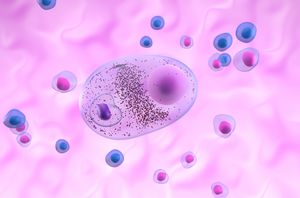
Parkinson’s disease is a brain disorder that causes unintended or uncontrollable movements, such as shaking, stiffness, and difficulty with balance and coordination. Symptoms usually begin gradually and worsen over time. As the disease progresses, people may have difficulty walking and talking. The basis of these symptoms is progressive neurodegeneration and accumulation of degradation-resistant intracellular aggregates, termed Lewy bodies, throughout the brain.
One of the major components of Lewy bodies is α-synuclein, a small protein that normally localizes at the presynaptic terminal of neurons where it regulates the release of neurotransmitters and possibly participates in the assembly of the cytoskeleton. The main characteristic of α-synuclein is that it is not tightly folded like most other proteins, but some regions of it can adapt to the shape of its interaction partners. The intrinsically disordered structure of α-synuclein also makes it prone to aggregation. Aggregated α-synuclein disrupts mitochondrial function and therefore leads to neuronal death. Moreover, aggregates of α-synuclein can act in a prion-like manner by seeding further aggregations, and spreading from one region of the brain to others, partially explaining the progressiveness of Parkinson’s disease.
The molecular mechanism behind α-synuclein aggregation and its correlation with Lewy body formation and neurodegeneration is poorly understood, and appropriate models for studying α-synuclein aggregation are lacking. The most common model for α-synuclein fibrillization is a seeding-based approach in which formation of intracellular aggregates is induced by adding a small amount of α-synuclein fibrils to a neuronal culture. Normally, the cells are then kept in culture for 14 days and α-synuclein fibrillization is studied. Under these conditions, however, only few cells show inclusions that resemble Lewy bodies.
Researchers from the lab of Professor Hilal A. Lashuel at the Ecole Polytechnique Fédérale de Lausanne (EPFL) in Switzerland hypothesized that the maturation process of transitioning from α-synuclein fibrils to Lewy bodies might require a longer time than designated by the standard model. Therefore, the authors prolonged incubation time from 14 to 21 days. At this later time point, inclusions with both an immunocytochemical profile and morphological structure similar to bona fide Lewy bodies were observed in about 20% of the neurons.
To characterize the effects of α-synuclein seeding over time, the authors used an antibody to label phosphorylated α-synuclein (pS129) which is the predominant form in Lewy bodies. In addition, they used antibodies labeling proteins that are a common component in Lewy bodies, like α-synuclein as well as ubiquitin and ubiquitin binding protein (p62) to characterize the effect of α-synuclein seeding. Finally, they used Amytracker 680 to label structures containing repetitive β-sheets to confirm the amyloid-like nature of the seeded aggregates. Indeed, Amytracker 680 colocalized with phosphorylated α-synuclein at days 7, 14 and 21 after seeding. While the seeded aggregates shared the immunohistochemical profile of Lewy bodies already at an early stage, the morphological features of bona fide Lewy bodies like their association with various organelles, including mitochondria became evident only at a later stage. It was observed in a few cases after 14 days, but was much more evident after 21 days.
Due to the observed association of Lewy Body-like inclusions with mitochondria, the authors investigated how the association with Lewy bodies affects mitochondrial function. They found that 21 days after the seeding of α-synuclein, but not after 7 or 14 days, mitochondrial respiration was severely impaired confirming that the formation of Lewy bodies might be associated with mitochondrial dysfunction. Using transcriptomic analysis, the authors showed that the expression of genes that regulate neuronal cell death was significantly altered at the later time points of the study. Furthermore, α-synuclein mRNA levels were significantly reduced at day 21 suggesting that the neurons are trying to prevent any further aggregation.
In summary, the publication by Mahul-Mellier et al. makes a strong point for increasing incubation times in seeding based models to be able to study the processes leading to the maturation and formation of Lewy bodies, which can reveal new insights into the pathogenesis of Parkinson’s disease.
Read More:
Other Resources:
- Panicker, N. et al. (2021) The cell biology of Parkinson's disease. J Cell Biol. 220(4):e202012095.
- Zeng, X.S. et al. (2018) Cellular and Molecular Basis of Neurodegeneration in Parkinson Disease. Front Aging Neurosci; 10:109.
- Kim, W.S., Kågedal, K. & Halliday, G.M. (2014) Alpha-synuclein biology in Lewy body diseases. Alz Res Therapy 6, 73.
